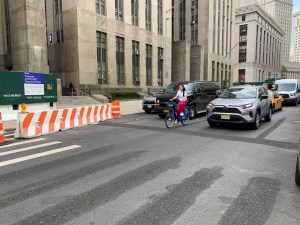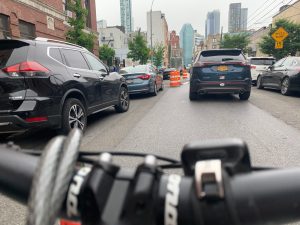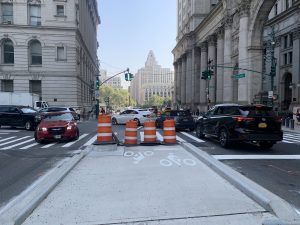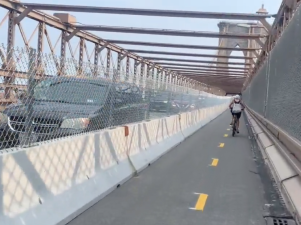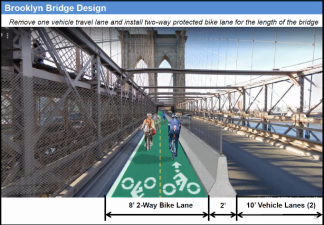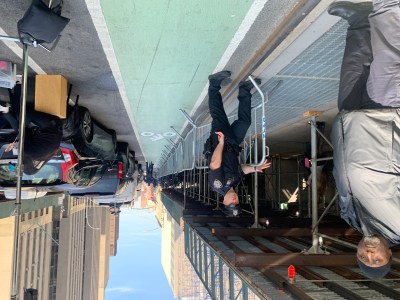Overruled! City Finishes Centre Street Bike Lane Despite Objections of Driving Court Workers
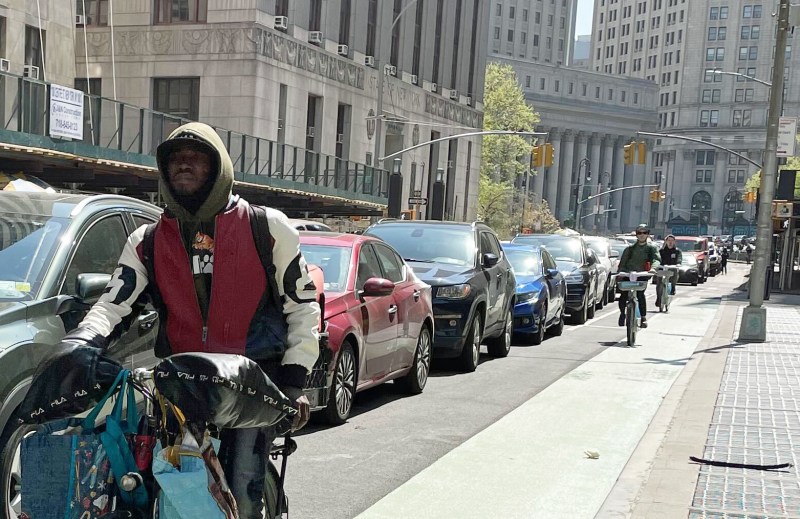
The verdict is in!
Court officials have thrown in the towel and will abide by the DOT’s protected bike lane outside the courthouses on Centre Street in Manhattan, according to a spokesman for the Office of Court Administration who reiterated the agency’s opposition to the new design as city crews filled in the project’s finishing touches.
“Our judges and non-judicial employees will of course abide by the new parking restrictions,” OCA spokesman Lucian Chalfen said in an email.
“Maybe time will tell if the lane and its tangential affects [sic] will be rethought by New York City.”
The city Department of Transportation painted initial bike lane markings outside the courthouses on Centre Street last year, but they had gone mostly unenforced until this week. DOT on Wednesday morning added green paint to the months-old bike lane markings, and on Thursday the block was blissfully free of the usual row of illegally-parked cars sporting government-issued placards:
https://twitter.com/vegitalist/status/1649060813477404673
The project was nearly two years in the making. Advocates cheered its completion, which solidified a protected north-south route to the new Brooklyn Bridge bike path — as long as it stays clear of parked cars.
“Great news! This lane was supposed to be an integral part of the hugely successful Brooklyn Bridge bikeway,” said Jon Orcutt, the communications and advocacy director at Bike New York. “Let’s hope it looks this good tomorrow and next week.”

For months, DOT’s partially complete bike lane markings went totally ignored by the municipal parking class, with cars lined up daily along the curb where there are now five blocks of green paint.
DOT presented its plans in September 2021 to eliminated a travel lane to make room for a northbound protected bike lane on Centre Street between Worth and Canal Streets, along with a southbound path over on Lafayette Street. The agency began putting down markings last summer, but left them unfinished amid opposition from court officials and their unions, Gothamist reported.
One of the few days the half-done Centre Street lane was clear for cyclists was during the indictment of former President Donald Trump on April 4, when cops fenced off much of the area.
Court officials have refused to acknowledge the need for or legitimacy of protected bike infrastructure just feet from the Brooklyn Bridge, with Office of Courts Administration spokesperson Lucian Chalfen likening the redesign to French efforts to fend off Nazi Germany during the 1930s in response to Gothamist earlier this year.
Reached for comment on Thursday, Chalfen conceded defeat but also claimed a bus “hit” a parked car while “trying to squeeze” down the regulation-sized travel lane. A “small piece” of a bus “hanging off the side of the vehicle” hit an unattended Kia, according to an NYPD spokesperson.
“While we have repeatedly made our opposition to the bike lane known for a number of reasons, not the least of which is a manufactured traffic bottleneck in between two of the busiest courthouses in New York City,” Chalfen said.

Nearly 68,000 cyclists crossed the Brooklyn Bridge last month, or about 2,200 a day, according to DOT bike counters.
The courts are in one of the transit-densest parts of the city, with almost every subway line running through the area. Judges and other employees drive to work because they “don’t like traveling on the train or public transportation and then bumping into people whose cases are in front of them,” a court officers union leader told Gothamist three months ago.
Reducing travel lanes roadways and installing protected bike lanes consistently reduces traffic violence across the city — leading to fewer injuries and deaths of people on foot, bikes, or in cars, city stats show.
Protected bike lanes and pedestrian islands cut the number of pedestrians killed or seriously injured by nearly 30 percent among pedestrians and between 15-18 percent for cyclists. DOT spokesman Vin Barone said the paths provide life-saving infrastructure.
“Speaking on behalf of traffic engineers and the thousands of New Yorkers who use this corridor on wheels and by foot, bike lanes save lives and we always appreciate the cooperation from our city and state partners to make our streets safer,” Barone said in a statement.
DOT is still finishing up the projects and made “minor adjustments” to its original plan in response to concerns from court staff, primarily updating curb regulations to facilitate courthouse operations, Barone said.
